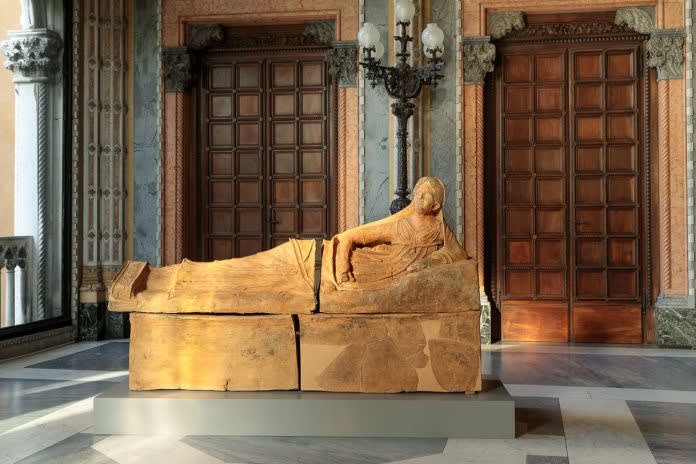IN MOSTRA A PALAZZO FRANCHETTI IL MONDO DEGLI ETRUSCHI E QUELLO DI MASSIMO CAMPIGLI. UN DIALOGO INTIMO E PROFONDO TRA LE DONNE-OROLOGIO E LE DONNE-ANFORA DELL'ARTISTA, MISTERIOSE E IMPASSIBILI, CON I REPERTI ETRUSCHI CHE GLI SUSCITANO UNA FELICITÀ PAGANA.

Massimo Campigli e gli Etruschi. La felicità pagana. Veduta della mostra presso ACP Palazzo Franchetti, Venezia 2021. Foto Francesco Allegretto.
Nella mostra allestita a Venezia negli spazi di Palazzo Franchetti (la cui gestione è affidata ad ACP - Art Capital Partners, società strettamente legata alla Galleria d'Arte Maggiore di Bologna), i curatori Franco e Alessia Calarota sottolineano il profondo dialogo tra trentacinque opere di Massimo Campigli (Firenze, 1895 - Saint-Tropez, 1971) con una cinquantina di reperti risalenti al periodo etrusco, con cui l'artista condivide atmosfere, segni, colori, emozioni. Le composizioni, chiaramente arcaiche, vanno dal 1928 al 1966.
Molte delle testimonianze della civiltà etrusca sono inedite e qui esposte per la prima volta, frutto di sequestri e restituzioni. Si tratta di forme che rappresentano statue votive. Figure femminili con busti/ clessidre immerse nella dimensione atemporale dell'astrazione. Ispirandosi a questi profili espressivi, Campigli ottiene quella particolare pittura, quel taglio compositivo originalissimo dove il tempo perde profondità. Ed è come vivere in una quiete impassibile, dove lo spazio è invaso da donne anfora.
LE DONNE-AMPHORA DI CAMPIGLI
Gli esegeti di Campigli si sono spesso soffermati sulla sua attenzione per la donna, così determinante per il suo universo creativo. Senza mai considerarla, salvo rare eccezioni, un oggetto sessuale. Da notare le eleganti strategie compositive che Campigli utilizza, all'interno delle quali i segni utilizzati veicolano sottotesti dai molteplici significati: la collana come gioiello e come catena, il diabolo come cordone e come anello, la ringhiera come abbellimento e come parapetto. La mostra si concentra sul rapporto dell'artista con l'altra metà del cielo, con donne che diventano clessidre, eleganti nei loro gioielli. Figure femminili rese attraverso schemi geometrici che si differenziano per colori e gesti, assumendo aspetti vagamente irreali. Tutte visioni che scatenano in Campigli una felicità pagana, come lui stesso la descrive, dopo aver visitato il Museo Etrusco di Villa Giulia nel 1928: "Nei miei quadri entrava una felicità pagana sia nello spirito dei soggetti sia nello spirito dell'opera che diventava sempre più libera. lirica”.

Massimo Campigli, Donne velate, 1943, olio su tela, 66×48 cm. Collezione privata, Bologna
LA STORIA DI MASSIMO CAMPIGLI
Lirismo e libertà narrativa sono certamente rintracciabili nella prima sala di Palazzo Franchetti, dove sono esposti due manufatti: un sarcofago e il dipinto Gli zingari del 1928. In primo piano una donna con la schiena nuda e un'anfora sotto il braccio sinistro appoggiato sul fianco, avvolta in una lunga gonna, guarda, forse, il cavaliere. In attesa. Ma lui, distante e nudo, rimane sul cavallo. Inattivo, guarda solo la luna.
Sullo sfondo frammenti di acquedotto romano, sofisticate costruzioni ingegneristiche che testimoniano il profondo legame di Campigli con la storia. A partire da lui, quando viene assunto al Corriere della Sera e inviato come corrispondente a Parigi. Pittore di giorno, giornalista di notte. Vive a Montparnasse e le visite al Café Dôme sono frequenti. Insieme a de Chirico, Mario Tozzi, Gino Severini, De Pisis, Renato Paresce e Alberto Savinio forma il gruppo dei "Sette di Parigi". Come se volesse legittimarsi e trovare una propria identità.
